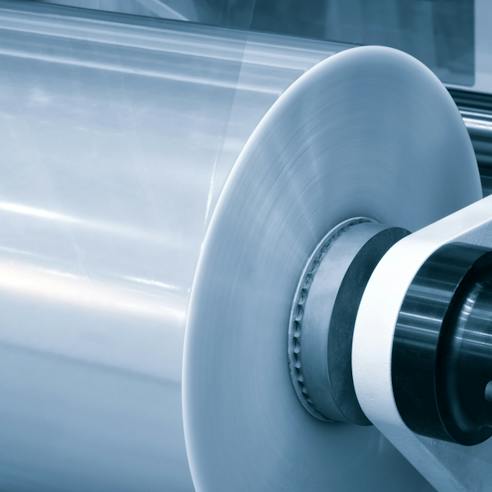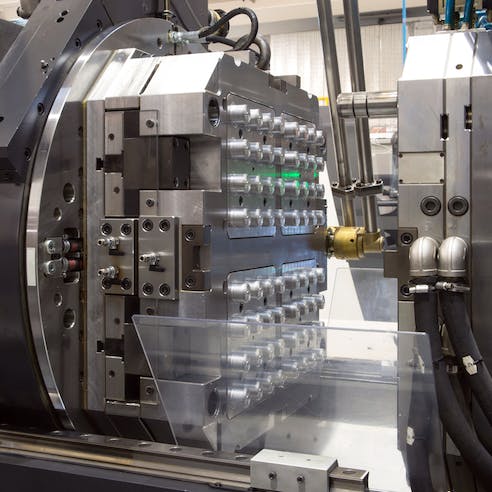Rotational Molding Services by Xometry
Get custom rotational molded prototypes and production parts in as few as five business days. Dozens of materials and finishes are available.
Rotational molding, also known as rotomolding, is a versatile manufacturing process that is known for its ability to produce complex, hollow plastic parts with excellent structural integrity. It is the process of melting a fine thermoplastic powder in a mold and slowly rotating the mold to produce parts with uniform wall thickness and high strength. Beyond consistent wall thickness and high strength, other advantages of rotational molding include low tooling costs and dimensionally stable parts. Different thermoplastic materials like polyethylene and polyvinyl chloride (PVC) can be used in the process to make parts like: bulk material and liquid storage containers, temporary safety barriers like traffic cones, sporting goods like kayaks and canoes, and automotive parts like wheel arch liners.
Xometry offers the highest quality rotational molding services for a variety of industries and applications. Our broad manufacturing and engineering experience ensures your rotationally molded parts are made to the highest quality standards.
What Is Rotational Molding?
Rotational molding, also commonly referred to as rotomolding or rotocasting, is a manufacturing technique used to fabricate hollow plastic products. The rotomolding process starts with the deposition of plastic resin powders into a mold. Afterward, the mold is slowly rotated as the plastic powder is heated and melted. The simultaneous heating of the powder and the rotation of the mold causes the plastic melt to spread evenly along the mold’s interior walls which results in a part with uniform wall thickness. Other advantages of rotomolding include: durability, high strength, aesthetically appealing parts, and cost efficiency.
Plastic rotational molding is made to make many different types of products for a variety of industries such as: packaging, pharmaceuticals, food and beverage processing, chemical processing, consumer products, and sporting goods. Examples of rotational molded products include: food and beverage packaging, chemical storage tanks, portable barriers, kayaks, and recreational playground equipment.
Rotational Molding Process
The rotational molding process is a straightforward 4-step process but requires attention to detail to obtain the desired quality in molded parts. Each type of plastic has a specific melting temperature, melt time, spin rate, and resin load to achieve the required wall thickness and dimensionally stable parts. In rotational molding, the mold is fixed on the end of a long rod which enables the movement of the mold between heating and cooling chambers. However, the actual axis of rotation of the mold is around the centerline of the rod.
The rotational molding process starts with depositing a plastic powder into the mold. Once the required amount of powder is poured into the mold, the mold is closed and clamped. Then, the mold is moved into a large oven or heating chamber in which the powder heats and eventually melts. As the powder melts, the mold also slowly rotates to ensure that the melted material evenly coats the walls of the mold to create parts with uniform wall thickness. Next, the mold is removed from the heating chamber and cooled, but continues to rotate. The mold can either cool in the ambient air or with a water spray. Finally, once sufficiently cooled, the mold is opened and the finished part is released.
Rotational Molding Materials
There are many different types of plastic materials that can be used for rotational molding. The materials are listed and described below:
- Polyethylene (PE)
- Cross-Linked Polyethylene
- HDPE
- LDPE
- PVC

Polyethylene (PE)
Polyethylene is a lightweight plastic often used in rotational molding due to its excellent chemical resistance, impact strength, and ease of processing. When it comes to rotational molding, PE is used to make parts like chemical and water storage containers and food and beverage packaging.
Cross-Linked Polyethylene
Cross-linked polyethylene, also known as PEX, is a variant of polyethylene that contains connective bonds known as cross-links in its chemical structure. Due to the cross-links in its structure, molecules in PEX are packed more tightly which leads to a heavier material compared to regular polyethylene. Additionally, PEX has a wider operating temperature range, and better abrasion, chemical, and UV resistance, but similar mechanical properties compared to regular polyethylene. Rotational molded products made with cross-linked polyethylene include chemical storage tanks and protective housings.
HDPE
High-density polyethylene (HDPE) is a variant of polyethylene whose side-chain branching of the repeating monomer ethylene occurs less frequently. Fewer side branches enable monomer chains to be located closer together—hence “high-density” polyethylene. As a result, HDPE has higher density, is less elastic, and is more resistant to load distortion than typical polyethylene. Common rotational molding applications include: chemical, water, and food storage containers, septic tanks, fuel tanks, crates, and various other packaging solutions.
LDPE
Low-density polyethylene is a variant of polyethylene characterized by a higher number of side branches extending from the monomer chain. More branches enable LDPE to be more flexible compared to standard PE, PEX, and HDPE. Beyond its flexibility, LDPE is also tough, corrosion resistant, and has high strength relative to its density. Rotomolding applications of LDPE include: enclosures for playground equipment, toys, trash bins, and buckets.
PVC
PVC is a thermoplastic composed of chains of vinyl chloride monomers. It is available in two forms: plasticized and unplasticized. Plasticized PVC is soft and elastic and is seldom used for rotational molding processes. Unplasticized PVC is hard, rigid, and tough, exhibits excellent chemical resistance, and is the type of PVC used for rotomolding processes. PVC rotational molded products include: storage containers, medical ventilation masks, and children’s toys.
_Injection-Molding.svg?fit=max)
Ready to make custom rotational molded parts?
Rotational Molding Advantages
The advantages of rotational molding are listed and described below:
Cost Efficient
Rotomolding is a cost-efficient process for many reasons. Firstly, the tooling needed for the process is cheaper compared to other molding processes like injection molding. This is because the pressures experienced during the rotational molding process are lower. Thus, tooling can be made from softer, cheaper materials like aluminum. Additionally, there is less material waste with rotational molding since products have defined recipes for the amount of powder required and because there are no runners or sprues developed by the process. Both these things lead to rotational molding being a cost-efficient process.
Uniform Wall Thickness
Consistent wall thickness is another advantage of rotational molding. The continuous rotation of the mold during the heating and cooling processes allows the molten plastic material to evenly coat the mold cavity walls. Uniform wall thickness leads to more rigid and stronger parts.
Double-Wall Construction
Rotational molding enables the fabrication of intricate open, double-walled containers without any extra post-processing steps. Features that would be difficult to mold in regular injection molding processes like strengthening ribs and molded-in inserts can easily be fabricated with rotational molding.
High Durability
High durability of parts is another hallmark of rotationally molded parts. Parts are molded into a single piece which eliminates the need for different fastening methods like welding, riveting, or the use of threaded fasteners. Additionally, parts are rigid because of the uniform wall thickness that can be achieved with the process.
High Stability
Another advantage of rotational molding is that parts exhibit high dimensional stability. Because molding pressures are low and molds aren’t subjected to external pressures like on typical injection molding machines, there is a reduced possibility of defects in the finished product.
High Strength
Corners of parts made by rotational molding are typically thicker which effectively reduces the stress concentrations at these regions of the part—further adding to a rotational molded part’s strength.
Appearance
Rotational molding tooling can easily accommodate various surface finishes and textures since tooling can be made from soft materials like aluminum. Different textures that produce different surface finishes (matte vs. glossy), symbols, logos, and letterings can easily be cut into the cavities of rotational molds to create aesthetically pleasing parts.
Rotational Molding Disadvantages
Despite its many advantages, rotational molding also has several disadvantages. Below are the disadvantages of roto molding:
High Cycle Times
Rotational molding can be a slow process and has high cycle times. Molds must rotate very slowly—up to eight rotations per minute—to obtain the desired wall thickness and appearance in parts. Consequently, it can take as long as three hours to complete a single part. High cycle times adversely affect the production output and bottom line of manufacturers.
Limited Material Options
While rotational molding is compatible with various thermoplastics, the range of materials available for rotational molding is limited compared to other molding processes like injection molding. This is because materials used in rotational molding must be converted into a thermally stable fine powder.
High Cost Of Raw Material
The cost of raw materials for rotational molding is more expensive compared to materials for other molding processes for a variety of reasons. Rotomolding raw materials are typically specially made. The additional processes needed to produce fine powders and required additives both contribute to the higher cost.
Low Repeatability
While softer materials like aluminum are cheaper to fabricate into tooling, softer materials are also more susceptible to wear and tear. Consequently, tooling made from softer materials may need to be refurbished or replaced in as little as 3,000 molding cycles.
High Labor Costs
Rotational molding requires more manual intervention compared to processes like injection molding, blow molding, and extrusion. Pouring the powder into the mold, clamping the mold, and removing the part must all be completed manually as automation of these processes has not yet been realized.
Applications of Rotational Molding
Rotationally molded products are used in a variety of industries and applications, some of which are listed and described below:
- Road Construction
- Agriculture
- Plumbing
- Sporting Goods
- Packaging
- Material Handling
- Automotive
- Toy Manufacturing
- Wastewater Management
- Pharmaceuticals
- Food And Beverage Processing
- Fuel And Oil
- Chemical Handling
- Marine Manufacturing

Road Construction
Cones, safety bollards, plastic jersey barriers, and other temporary road safety barriers can be made by rotational molding.
Agriculture
Rotational molding is sometimes used in the agriculture industry to produce parts like: livestock feeding troughs, crop sprayer tanks, and other agricultural tanks.
Plumbing
Rotational molding is used to create products for plumbing applications. Products like: septic tanks, water storage tanks, rain harvesting systems, grease traps, and protective pump housings can be created by rotomolding.
Sporting Goods
Fitness equipment like: jump boxes, step platform trainers, bike racks, and watercraft such as kayaks and canoes can be made by rotational molding.
Packaging
Rotational molding is used to make packages of many different types and geometries. Some examples are: fuel and oil containment, food and beverage processing, and wastewater treatment.
Material Handling
Material handling solutions can easily be fabricated by rotational molding. Products like: pallets, crates, shipping containers, utility carts, trash cans, coolers, and various other packaging products can all be made by rotomolding.
Automotive
Rotational molding can be used to make automotive parts like: fuel tanks, wheel arch liners, air ducts, and bumpers.
Toy Manufacturing
Rotational molding is used in the fabrication of toys and recreational equipment like balls and playground equipment.
Wastewater Management
Wastewater and stormwater management products like: water tanks, septic tanks, drainage and catch basins, biofilters, and aeration tanks can be made by rotational molding.
Pharmaceuticals
It is possible to rotomold material storage containers, liquid storage tanks, waste bins, soap dispensers, handwashing stations, protective instrument housings, etc.
Food And Beverage Processing
Items like: bulk material containers, liquid storage tanks, and coolers can be made by rotational molding.
Fuel And Oil
Rotomolding is commonly used to create tanks with volumes from a few liters up to 50,000 liters. Different types of fuel and oil can be stored in containers made from rotational molding.
Chemical Handling
Chemical tanks of up to 50,000 liters can be created by rotational molding. These tanks can be used to store everything from water and fuel to caustics and acids.
Marine Manufacturing
The rotational molding process can be used to create parts for marine applications like: floats, buoys, and pool liners, as well as watercraft like kayaks and pontoons.
Alternatives to Rotational Molding
There are a few alternatives to rotational molding if the process is cost-prohibitive or not viable due to the required part volume or geometry. Alternative processes to rotational molding offered by Xometry are listed and described below:
- Injection Molding
- Blow Molding

- Injection Molding: Injection molding is a plastic molding process that involves melting plastic pellets, forcing the molten plastic into a mold, and holding it under high pressure to form the part. It can be used to make many of the same products as rotational molding but often requires higher initial investment and higher operating costs. However, injection molding may be preferred over rotational molding if producing large volumes of parts, complex parts, or parts with stringent tolerances.
- Blow Molding: Blow molding is a molding process that uses a plastic tube that is heated and inflated to fabricate hollow plastic products. While blow molding can make many similar products to rotational molding, it offers manufacturers greater productivity and the ability to produce larger volumes of hollow parts. Parts like: bottles, fuel tanks, containers, and protective casings can all be made by blow molding.
Why Choose Xomety for Rotational Molding?

Endless Options
Choose from millions of possible combinations of materials, finishes, tolerances, markings, and certifications for your order.

Easy to Use
Get your parts delivered right to your door without the hassle of sourcing, project management, logistics, or shipping.

Quality Assurance
We are ISO 9001:2015, ISO 13485 and AS9100D certified.